
|
|
 |
||||||||||||||||||||
|
|
|||||||||||||||||||||
|
In this department, we bring you compelling stories of animals in the wild that are in danger of being lost to us - animals that are quite literally on the brink of extinction. Whether due to man's careless disregard for their habitat and its destruction, or because of overfishing or hunting, or due to chemicals or predators that we've introduced into their environment, these are profiles of the animals who most need our time, attention and protection. It's our hope these short articles will inspire you to get involved on whatever level you feel most comfortable: whether that's by donating your time or money to organizations dedicated to helping the animals we profile, traveling to see them in their natural environment, or personally contacting local, national or international government representatives to let them know that when an animal disappears forever, it is everyone's loss. To that end, we'll make mention of an organization or two at the end of each article dedicated to helping the animal we've profiled. We encourage you to enjoy the diversity of life on Earth and to share in the stories of the animals that live alongside us, but that nevertheless remain On The Brink... *************************************************************************************** OWLS (Tyto) By Jon Deinzer "A wise old owl sat on an oak; The more he saw the less he spoke; The less he spoke the more he heard; Why aren't we like that wise old bird?" 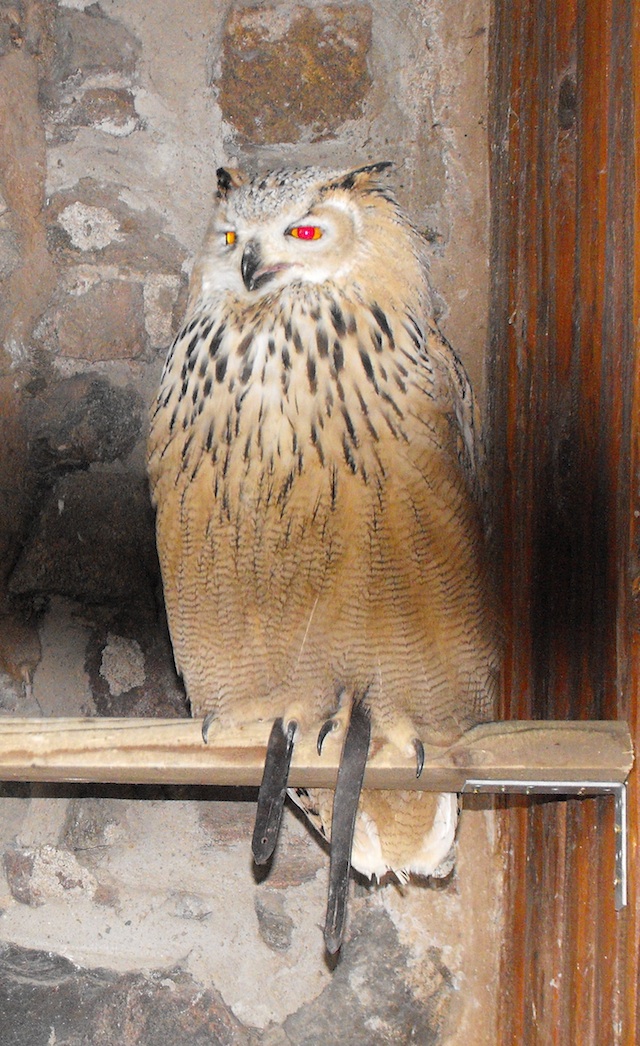 Although we often associate the owl with being a ‘wise old bird,’ man hasn’t behaved quite so wisely when it comes to the owl's preservation. Several species are already considered by wildlife experts to be endangered, and many others (although not considered globally threatened) are under the watchful eyes of national conservationists. Although we often associate the owl with being a ‘wise old bird,’ man hasn’t behaved quite so wisely when it comes to the owl's preservation. Several species are already considered by wildlife experts to be endangered, and many others (although not considered globally threatened) are under the watchful eyes of national conservationists.Owls are also having a harder time finding safe and secure breeding sites. Relying heavily on dark, secluded nesting sites (such as old buildings, abandoned barns, old growth forests and other forgotten places), they seek out quiet locations where they can breed and raise their young in peace. But their options are dwindling. The usual suspects rear their collective ugliness in the owls’ undoing: they are dramatically threatened by the loss of habitat, and with that the habitat of their prey. Cultivation of rural land for farming, urban housing sprawl, massive agricultural farming practices, roads and highways have cost the small animals that are prey to owls to fall as prey to progress instead. With that, many of the food sources owls need to survive are becoming increasingly scarce. Most owls are nocturnal, actively hunting their prey in the hours between dusk and dawn. Owls rely heavily on the element of stealth and surprise to perform their nightly ritual. Owls are blessed with feathers that are specially designed to muffle the sound of their wings as they travel in the darkness. They also possess dull coloring on their feathers that can render them almost invisible under certain lighting conditions. With razor-sharp talons and beaks especially designed to rip and tear, this nocturnal animal is a nighttime nightmare to all things small. Like every animal, they have a need to feed. That need is especially important during the breeding season, when the female is reliant on her partner for sustenance. After laying her eggs primarily atop the nest, the female owl will then incubate them with her body; meanwhile, the male searches the nearby woods and grasslands for rodents, small mammals and fish. Many owls have been on the endangered species list for years. The most famous would be the Northern Spotted Owl that inhabits the old-growth forests of the Pacific Northwest. The United States Fish and Wildlife Service (USFWS), which is supposed to protect and defend our endangered species, has approved logging permits for the Rogue River Basin - located in the very heart of Spotted Owl habitat. To keep environmentalists off their back, the USFWS produced permits for the “incidental take” of owls. In a nutshell this means that owls that are killed, harassed or harmed by logging companies are now considered to be acceptable casualties of the industry. Conservation groups are fighting to stop the sale of these permits. As it stands now, apparently the ‘take’ statement was deemed “arbitrary and capricious on several counts,” because it did not allow for a scientific means of tracking how many owls were being destroyed by logging. So it appears that yet again another speechless creature, in this case the owl, that performs an integral service for the environment, is caught between mans’ quest for commerce and its right to survive. To find out how you can get involved in owl conservation, either by making donations or volunteering your time, visit the World Owl Trust at: http://www.owls.org/ Photo credits: Erin Caslavka *************************************************************************************** KOALAS (Phascolarctos cinereus) By Jon Deinzer 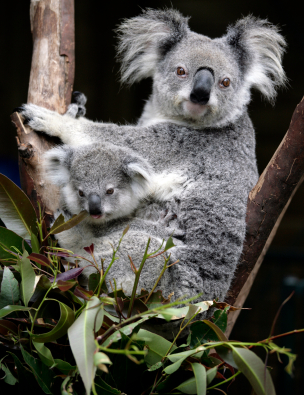 Many of us have seen the pictures of dehydrated koalas during the devastating heat wave that engulfed Australia. But heat is not the worst calamity to stalk the cuddly marsupial. AIDS, STD’s and loss of habitat are combining to send this beloved creature into a death spiral. It has been reported that the koala population (in the wild) has dropped from 100,000 to fewer than 43,000 during the last six years. Although loss of habitat, vehicle strikes and household pets claim hundreds every year, koala AIDS and STD’s are moving them towards extinction. Koala Immune Deficiency Syndrome was identified by Dr. John Hanger and he recently told CNN, “The disease is as severe as it is in humans, but is attacking koalas faster.” The disease is spread much the same way as it is in humans and it’s believed that most koalas are carriers; yet only select individuals actually get the disease. This koala retrovirus alters the animals’ DNA and has been linked to a variety of illnesses from leukemia to bone marrow cancer. Koalas are also very susceptible to chlamydia, which attacks their eyesight and urinary track, and ultimately leaves them infertile. Experts believe that up to 50% of Australia’s wild koalas are already infected with the disease. Recently, “Sam” - one of Australia’s most famous koalas, who was rescued from a bush fire earlier this year - was put to sleep after a chlamydia infection had decimated her internal organs beyond repair. Organizations like The Australian Koala Foundation, Australian Wildlife Hospital and Wildlife Warriors Worldwide are fighting back. A vaccine will soon be starting “trials testing” for chlamydia, and donations are being encouraged to help accumulate the $1.7 million needed over the next two years to help distribute the vaccine to the animals that need it most. Unfortunately, no funding from the Australian government (even though the animal is iconic to the country) has been committed to aid in the fight to save Australia’s wild koalas. For more information on what you can do to help Australia's iconic koala, go to: www.savethekoala.com (the website for the Australian Koala Foundation). Photo credits: iStockphoto.com ************************************************************************************** THE SHARK (Selachii) By Katey Pfeil 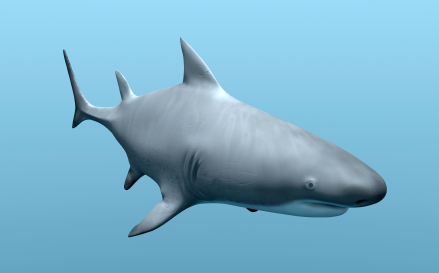 Some 300 million years ago, when dinosaurs still roamed the earth, sharks prowled ancient waters with the same stealth and forte that would enable their species to become the ultimate aquatic guardians that they are today. Although the modern shark as we know it did not evolve until approximately 100 million years ago, their primordial history is an impressive feature in itself. Because of their dominate role at the top of the oceanic food chain, sharks play an integral role in maintaining the delicate marine ecosystem they head. A perfect example of Charles Darwin’s “survival of the fittest” theory, sharks have evolved over time to be a virtually indestructible aquatic creature, as they have no real predators besides other sharks and humans. There are over 350 different kinds of sharks and one species, the bull shark (which can grow to an impressive 11 feet in length and weigh up to 500 lbs.) has even adapted to fresh water. Sharks live in oceans world-wide, with most large sharks living in the open sea. Sharks roam long distances to find prey and give birth. Unlike other animals who may reside in the same area for most of their lives, sharks are generally not very territorial and once a baby shark is born it is ready to take care of itself on its own. Although sharks vary widely by species, some sharks can lose up to 30,000 teeth in their lifetime that are constantly replaced by new teeth. Furthermore, since sharks rarely get tumors, scientists are currently studying shark cartilage in hopes of developing a possible cancer cure. Despite their association (especially in western culture) for being unscrupulous man-eaters, the truth is that an average of only 10 people die worldwide from shark attacks each year, according to Barry Tobin of the Australian Institute of Marine Science. Surprising right? Research shows that commonly held negative opinions concerning sharks stem from their portrayal on television and film (think the terror evoked by Steven Spielberg’s 1975 film, Jaws.) In fact, more people die in vending-machine related accidents or bee stings each year than are killed by sharks, according to the same source. Although commonly thought of as frightening and devilish in western society, sharks have long been celebrated, and even worshiped, in many Pacific Island cultures. However, sharks are not invincible. Despite their amazing ability to adapt to plenty of environmental changes over the ages, there is one devastating threat facing the success of shark species today: man. Over the last several decades, the growing demand for shark fin soup (a delicacy in Asian cultures, especially Chinese) has prompted a huge surge in shark catches. 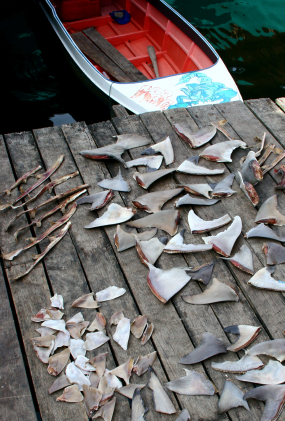 Sadly, sharks caught for use in soup are usually de-finned and immediately thrown back in to the ocean to bleed and drown to death - both a cruel and ecologically unfit practice. Sadly, sharks caught for use in soup are usually de-finned and immediately thrown back in to the ocean to bleed and drown to death - both a cruel and ecologically unfit practice. With a single bowl of shark fin soup fetching upwards of $400 in some swanky restaurants, it is no surprise some fisherman are capitalizing on the multi-billion dollar business of shark finning. Aside from shark fin soup, shark fins and meat are also used to make items such as shark tooth jewelry, belts, wallets, cosmetic products and various traditional medicines. Sharks are all too often the inadvertent victims of by-product fishing, whether by nets or long lines (strung dozens or hundreds of miles across the ocean) meant for tuna or swordfish. According to the International Union for Conservation of Nature, more than 25% of sharks in the north-east Atlantic are at risk of extinction and another 20% have been put in a near threatened category. The species most at risk include angel, gulper, sawfish and guitar sharks. Unfortunately, some types of shark (like the spiny dogfish) often end up on the menu as rock salmon or in fish and chips. Because sharks are long-lived animals that are slow to mature, their populations are extremely vulnerable to overfishing. One species (the spiny dogfish) has a gestation period of two years, and is not ready to reproduce until age 35. Furthermore, a drop in the number of predatory sharks will have a direct effect on other species as well. (For instance, a major decline in sharks in the Northern Atlantic after 2000 caused the sharks’ prey - the cownose ray - to increase. In turn, the rays reduced the North Carolina bay scallop population so drastically, that a fishery that had operated for more than a century was forced to close.) Shark conservation groups worldwide focus their energy on improving shark protection laws and catch limits, while generating awareness concerning shark meat. Many organizations carry out their plans by asking for donations, while others feature “adopt a shark” programs. To educate children on shark conservation, or to "adopt a shark," go to: www.adoptashark.com To sign a petition to stop the practice of shark finning at: www.change.org/petitions/view/put_an_end_to_brutal_shark_finning Plan to visit a seafood restaurant soon? Learn more about shark safe dining and venues that honor the shark-safe logo by going to: www.sharksafe.org For current information regarding shark conservation and policies visit: www.sharkalliance.org Photo credits: iStockphoto.com *************************************************************************************** PRZEWALSKI'S HORSE (Equus ferus przewalski) By J. Mark Robinson  Imagine showing up at the court of the 19th century Russian czar with the hide and skull of a horse that was practically unknown in the west. When explorer Nikolai Mikhailovich Przewalski returned to Russia from one of his geographic expeditions to Central Asia, he brought with him remains from a horse that was already rare in its native environment; and less than 100 years later, it was seen for the last time in the wild. Imagine showing up at the court of the 19th century Russian czar with the hide and skull of a horse that was practically unknown in the west. When explorer Nikolai Mikhailovich Przewalski returned to Russia from one of his geographic expeditions to Central Asia, he brought with him remains from a horse that was already rare in its native environment; and less than 100 years later, it was seen for the last time in the wild. By the end of WWII, there were only about 40 Przewalski’s (also known as the Asian wild horse) remaining in captivity. However, due to the efforts of a variety of European zoos (which had imported the animals at the turn of the century), their numbers started to slowly increase. Captive breeding was also initiated in China at the Xinjiang Wild Horse Breeding Center with the goal of reintroducing the species to its native habitat in China and Mongolia. A successful reintroduction program was also started in Hungary, where close to 100 are now living in relatively wild conditions. Places  such as zoos, the Khustain Nuruu National Park, the Takhin Tal Nature Reserve, Khomiin Tal, and the Hungarian wild have a combined population of approximately 2,000 Przewalski's horses. These hardy animals, with bristly manes that stand straight up, can endure temperatures that drop well-below freezing. But perhaps, especially in the day-and-age of disappearing species, the most remarkable feature of the Przewalski’s is that they are the only surviving bred of wild horse that remains. such as zoos, the Khustain Nuruu National Park, the Takhin Tal Nature Reserve, Khomiin Tal, and the Hungarian wild have a combined population of approximately 2,000 Przewalski's horses. These hardy animals, with bristly manes that stand straight up, can endure temperatures that drop well-below freezing. But perhaps, especially in the day-and-age of disappearing species, the most remarkable feature of the Przewalski’s is that they are the only surviving bred of wild horse that remains. Recently named by the Wildlife Conservation Society Institute (WCSI) as one of 2010 "Rarest of the Rare," it was also noted as being one of 2010's animal success stories. Notes Kent Redford, director of the WCSI, "While the news is dire for some species, it also shows that conservation measures can and do protect wildlife if given the chance to work." For more information on the Przewalski's horse, visit the Smithsonian National Zoological Park online at: www.nationalzoo.si.edu Photo credits: iStockphoto.com *************************************************************************************** THE SUMATRAN TIGER (Panthera tigris sumatrae) By Jon Deinzer  The last stronghold for tigers in Indonesia is the small island of Sumatra. Tigers were once widely known on the islands of Java, Bali and Sumatra and their numbers were measured in the thousands. However, the sub-species found on Java and Bali were exterminated in the 20th century. The last sighting of a tiger on the island of Bali dates back to the mid 1930’s and the last recorded sighting on the island of Java was in 1976. It’s a sad fact that these magnificent animals are gone forever. The last stronghold for tigers in Indonesia is the small island of Sumatra. Tigers were once widely known on the islands of Java, Bali and Sumatra and their numbers were measured in the thousands. However, the sub-species found on Java and Bali were exterminated in the 20th century. The last sighting of a tiger on the island of Bali dates back to the mid 1930’s and the last recorded sighting on the island of Java was in 1976. It’s a sad fact that these magnificent animals are gone forever.This leaves the Sumatran tiger as the last surviving tiger sub-species found in Indonesia. Smaller than typical tigers, the Sumatran males averages about 8’ in length and weighs in at about 265 lbs. The females are slightly smaller and lighter. This smaller frame helps the tiger maneuver quickly through the jungle. Highly evolved to their surroundings, the webbing between their toes, when spread, helps the Sumatran tiger to become a very fast and efficient swimmer. They have been known to chase their prey into the water where their swimming ability helps to make a successful kill. Interestingly, popular belief has it that the reason orangutans spend such a minimal amount of time on the ground is their fear of tiger attacks. Sumatran tigers can breed at any time during the year, however they prefer to mate in the winter and spring. Gestation is normally around 100 days, with tigers reaching full maturity somewhere around four years of age. A typical litter is two or three cubs, however there can be as many as six. Cubs leave the den for the first time after three months, but are completely dependent on the female until they reach about six months old when their killing instinct begins to develop. By the time they are approximately a year-and-a-half, they can hunt for themselves but are completely independent by the age of two. Life expectancy in captivity is twenty years; in the wild - much, much less. With fewer than 400 known tigers left in existence, the  Sumatran tiger is doomed unless the thoughtless trade in its body parts is stopped and its natural habit saved. Acceleration of deforestation for agriculture and rampant poaching mean that even without a further loss of life, the tigers hopes of a successful come back may have run out. Although it is now illegal to hunt tigers in Sumatran tiger is doomed unless the thoughtless trade in its body parts is stopped and its natural habit saved. Acceleration of deforestation for agriculture and rampant poaching mean that even without a further loss of life, the tigers hopes of a successful come back may have run out. Although it is now illegal to hunt tigers in Indonesia, countries such as China, Taiwan, South Korea and other neighboring Asian nations still clamor for medicines made from the bones and skins of these tigers. Until education can quell the thoughtless demand for body parts, it appears that the fate of the Sumatran tiger is identical to that of its extinct cousins’. For information on conservation efforts directly aimed at helping the Sumatran Tiger, go to: www.tigertrust.info. Photo credits: iStockphoto.com *************************************************************************************** THE ALBATROSS (Diomedeidae) By Erin Caslavka 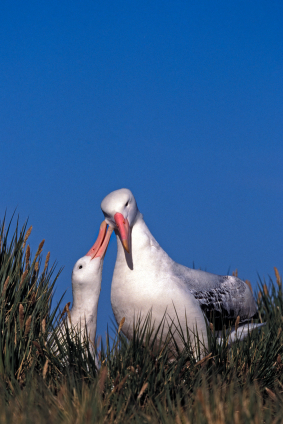 Take a look at any one of a number of healthy seashores and you’re likely to glimpse the albatross, a tube-nosed seabird that gets its name from its unusual bill. Formed from several plates of horn and equipped with two tubes that eliminate the salt they ingest in sea water, the albatross’ bill is an extraordinary example of a physical characteristic that’s paramount to its owner’s survival. Take a look at any one of a number of healthy seashores and you’re likely to glimpse the albatross, a tube-nosed seabird that gets its name from its unusual bill. Formed from several plates of horn and equipped with two tubes that eliminate the salt they ingest in sea water, the albatross’ bill is an extraordinary example of a physical characteristic that’s paramount to its owner’s survival. Albatross primarily reside in the polar and sub-polar regions of the Southern Hemisphere, and all albatross species are birds of the open ocean. They are so comfortable on the water, in fact, that they spend the vast majority of their time there, only flying to shore when they’re seeking a mate, breeding or raising their young. Due to their long, slender wings, they require winds of at least 7 mph or they become incapable of taking off (another reason why their time at sea is so much preferred). However, once airborne, they can cover thousands of miles using their 12-foot wingspan to help keep their 25-lb. bodies in the air. They also tend to glide, rather than beat their wings. 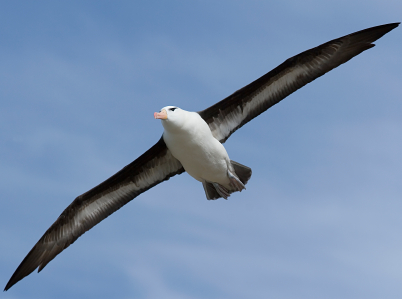 Of all the albatross species, the Amsterdam albatross is the most threatened, with only about 130 remaining; for the waved albatross, the situation is much the same. This species is found off the coasts of Peru and Ecuador, with its breeding grounds on Espanola Island, in the Galapagos. Although the bird is protected, disease and the negative effects of tourism are the factors that contribute most to its critically endangered status. Another concern for the birds - in particular the royal albatross - is their vulnerability whenever fishing fleets are around as the birds tend to swallow bait laid out by fishermen, complete with hooks. At the beginning of the 20th century, entire colonies of albatross were wiped out as a result of a desire for their feathers, which were popular as filling material for bedspreads and pillows. These days (in addition to the aforementioned hazards of fishing) industrial pollution, swallowing hard bits of plastic they mistake for food, and the introduction of domestic animals in areas they’ve historically used for breeding have also contributed to the sharp decline in their numbers. And because most albatross species only hatch a single chick every two years, any disruption to their breeding cycle is hard to compensate for.  Protection and conservation efforts of the albatross have expanded to include a variety of organizations working together to try to further understand the place that seabirds have in the ecology of the worlds’ oceans. However, until adequate steps can be taken to ensure their safety from fishing lines, gill nets and pollution in the waters they call home, the future of their survival remains at stake. For information on the albatross species of the Pacific Ocean, visit: www.pacificseabirdgroup.org For information on the albatross species of Australia, go to: www.birdsaustralia.com/au For the Save the Albatross global campaign (sponsored by Birdlife International), visit: www.rspb.org.uk/supporting/campaigns/albatross Photo credits: iStockphoto.com *************************************************************************************** THE BLACK RHINOCEROS* (Diceros bicornis) By Jeannine Clark  Most of us will probably never catch a glimpse of the gentle and timid rhino in the wild. Shy and seldom seen, rhinos have no natural predators except for humans, and are not naturally aggressive unless startled. Like people, rhinos greatly impact other species with their actions. For example, black rhinos in Africa only browse on the tips of shrubs and small trees, pruning them and keeping growth under control, thus allowing other species to thrive in an ecosystem that works for all living within it. If rhinos disappear from their habitat, so do many other animals. Most of us will probably never catch a glimpse of the gentle and timid rhino in the wild. Shy and seldom seen, rhinos have no natural predators except for humans, and are not naturally aggressive unless startled. Like people, rhinos greatly impact other species with their actions. For example, black rhinos in Africa only browse on the tips of shrubs and small trees, pruning them and keeping growth under control, thus allowing other species to thrive in an ecosystem that works for all living within it. If rhinos disappear from their habitat, so do many other animals. If numbers are a clear-cut way to determine an equation, consider this: in the past 100 years, the black rhino population has decreased by 96%, making it the fastest-declining of the five rhino species worldwide. Out of the four subspecies of black rhinos - eastern, southwestern, southern central and western - the latter is thought to already be extinct. This alarming fact not only has conservationists troubled and working tirelessly to combat the sharp decline in the numbers of the remaining three subspecies, but this by-product of human interference (through poaching and loss of habitat) affects every future generation as each species’ departure impacts the next. Zimbabwe is home to the fourth-largest population of black rhinos, numbering a mere 490 in 2008. But that country’s population is in severe danger due to poaching. Zimbabwe is one of the poorest, most unstable countries in the world, and as a result of the continually deteriorating political and economic climate, there’s been a dramatic upsurge in wildlife poaching. Rhinos are poached primarily for their horns (which are made up of finely compacted hair), as they’re believed to possess aphrodisiacal qualities. The horns are also used in Africa and Asia for decorative purposes. Despite the ban on poaching in 1980, rhinos are still continuously hunted. Baby rhinos (usually staying with their mothers for protection until they are 3-5 years old) have been found by their mother’s side long after she was shot and killed. Conversely, there are about 14,500 southern white rhino still left in the wild in Southern Africa, and their survival today is a conservation success story as their numbers were less than 100 in 1895. However, in recent years, the northern white rhino subspecies has been pushed to the brink of extinction due to poaching in Northern Congo. The civil war in that country has made accessibility for conservation organizations near impossible, and it is now believed that only 10 northern white rhinos remain in Garamba National Park. Translocation of rhinos from high-risk areas to safer locations is one way groups such as the International Rhino Foundation (IRF) address dwindling populations. Conservationists with IRF also treat rhinos with snare wounds or other injuries and return them to the wild, as well as help authorities track, apprehend and prosecute poachers. With intensive tracking, medical treatment and monitoring of rhinos, their hope is to ensure the rhino’s safety and increase their overall numbers. Usually, the average person’s primary (or only) exposure to the second most massive land animal in the world is via the ones kept in captivity: where, though not ideal, at least they are protected. In September of 2001, Emi, who lives at the Cincinnati Zoo, gave birth to a healthy 72.6-pound calf named Andalas. This was the first time in 112 years that a Sumatran rhino successfully reproduced in captivity. (A female rhino can give birth only once in three years, with a gestation period lasting 15-16 months.) Far more likely is the fact that most of us will never get to see them grazing on herbaceous plants or wandering the plains in Africa or Asia; but if more isn’t done to save this powerful animal in the wild, they may soon be lost to us forever. *Editors note: The Western Black Rhino of Africa was declared officially extinct in November, 2011 by a leading conservation group. The International Union for Conservation of Nature said that two other subspecies of rhinoceros were close to meeting the same fate. www.rhinoresourcecenter.com/species/black-rhino/ www.rhinos-irf.org/rrc www.panda.org/what_we_do/endangered_species/rhinoceros/african_rhinos/white_rhinoceros/ www.worldwildlife.org/species/finder/rhinoceros/rhinos.html Photo credits: courtesy of the Rhino Resource Center *************************************************************************************** THE INDIAN HOG DEER (Axis porcinus) By Jennifer C. Cook  As one of the smallest deer in the world, the hog deer is a good example of what it means to have a “short man’s complex.” The male hog deer is one of the more aggressive of his species, which is especially pronounced when it’s mating season. In autumn, male deer will gather out in the open and antagonize one another hoping to get noticed. The males will focus on only one female when they’re in pursuit of an amorous encounter, but unlike other types of deer they don’t utilize a mating call: fighting amongst themselves is the only known form of a mating ritual. Still, while some may perceive the tiny deer’s aggressive behavior as a compensation for their lack of height, their short stature does come in handy. Once the mating season is over, the deer return to the tall grasses closest to riverbeds in the Pakistan and Indian mountain ranges. If all goes well, after a gestation period of about six months the female hog deer will give birth to only one deer, which is kept hidden in the grasses of the riverbeds to protect them from predators like Bengal tigers. This means that most deer are born during monsoon season, when new grass is plentiful. The newborns are born brown, not bearing the spots of their older counterparts, but it’s common for them to develop spots during the winter months. However, their coloring isn’t the only thing they use for cover: it’s thought that the reason for this deer’s pig-like name is because it runs with its head low to the ground, and doesn’t leap like other deer - keeping it relatively unnoticed by predators. Unfortunately for the hog deer, housing developments and other projects have lead to dwindling numbers. Developments like building dams for the river Indus have caused disruptions in the deer’s ability to access its food supply and to hide from their natural predators. Once plentiful in the region of southeast China, the deer are now near-extinct there and unfortunately their numbers are dwindling elsewhere. The hog deer has also become a favorite target of game hunters on private reserves. However, Chinese scientists at the Yongde Nature Reserve have been seeking ways to encourage breeding in the wild as they hang on to the hope that the hog deer will be able to restore its population. For
more
information
on the Indian Hog Deer visit the International Union for Conservation of Nature (IUCN) at: www.iucn.org. *************************************************************************************** THE POLAR BEAR (Ursus Maritiumus) By Katey Pfeil  Worldwide, ice caps are diminishing at an alarming rate - and unfortunately, those suffering the brunt of this crisis had nothing to do with its origins in the first place. The majestic polar bear, which has thrived in the Arctic for centuries, is now in danger of becoming extinct as his frozen platforms, which provide habitat and food, vanish forever. Worldwide, ice caps are diminishing at an alarming rate - and unfortunately, those suffering the brunt of this crisis had nothing to do with its origins in the first place. The majestic polar bear, which has thrived in the Arctic for centuries, is now in danger of becoming extinct as his frozen platforms, which provide habitat and food, vanish forever.Polar bears are known for their massive bodies, weighing in at around 1100 pounds. Their bodies supply the fat that will keep them warm throughout the year, while their white coats provide ideal camouflage. In every way, the polar bear is naturally equipped for life in frigid North Pole regions. The polar bear is the second-largest land predator, outdone only by the Kodiak bear. Polar bears are 8-9 feet long and stand an impressive 5-6 feet high at the shoulder. Sadly, scientists estimate there are as little as 20,000-25,000 polar bears alive in the wild. Over the last several decades, increased stress to polar bear habitats has had a negative effect on their growth rate. Besides climate change, factors such as drilling, industrial mishaps like oil spills and increased human interactions (recreational tours promoting polar bear sightings, etc.) have all hindered the bear’s delicate breeding and gestation periods. However, the cruel sport of polar bear trophy hunting is perhaps the most obvious manifestation of man’s negative impact on polar bear populations: Although such hunting is banned in Alaska, Canada (where about 60% of the world’s polar bear population lives) has not yet banned the sport that encourages individuals to kill bears and export pelts and body parts. However, scientists are emphatically citing global warming as the main variable responsible for polar bear population decline. Although there are conflicting opinions regarding that theory, according to the National Resource Defense Council (NRDC), Arctic ice caps have shrunk by a size equivalent to the size of California - times six. This is alarming news for the Arctic’s bears, since the melting ice will result in total obliteration of their habitat in the not-too-distant future. Although polar bears could stay on land throughout the year and not drown, there would be no way 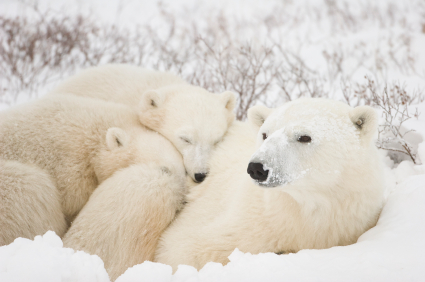 for them to access their food sources (such as seals and fish) that dwell underneath the ice’s surface. As a result, fading ice caps force the bears to swim greater distances in a desperate attempt to locate food. Such stress causes them to loose dangerous amounts of body fat, which often results in reproductive problems such as birth-defects and the inability to produce milk for their young. Sadly, the increased for them to access their food sources (such as seals and fish) that dwell underneath the ice’s surface. As a result, fading ice caps force the bears to swim greater distances in a desperate attempt to locate food. Such stress causes them to loose dangerous amounts of body fat, which often results in reproductive problems such as birth-defects and the inability to produce milk for their young. Sadly, the increased distance the bears must swim in order to find food often causes fatigue and even death. Furthermore, some scientists believe that the sea has declined severely over the last half century, while additional declines of 10%-50% are expected by 2100. Because of their long gestation periods and the current speed of global warming, it seems unlikely that the bears will be able to adapt to their changing environment. Conservation efforts dedicated to preserving the polar bear are currently focused on convincing the U.S. government to include the bear on the endangered species list in order to provide the bears with greater protections, including increased habitat security. Outside of the U.S., organizations such as the NRDC are working to protect Canada’s polar bears (of which over 600 have been killed in the last decade.) Protections will 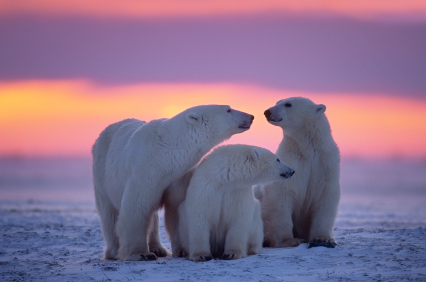 come from banning trophy hunting and ending global trade in polar bear parts by pushing for stronger international protections under the Convention on International Trade in Endangered Species (CITES). come from banning trophy hunting and ending global trade in polar bear parts by pushing for stronger international protections under the Convention on International Trade in Endangered Species (CITES).For
more
information on current conservation efforts on behalf of the Polar Bear, visit: www.polarbearsinternational.org or www.iucn.org. To learn how you can get involved in relieving the Polar Bear's struggle via direct donations, visit the Natural Resources Defense Council at: www.nrdc.org. Photo credit: iStockphoto THE KIWI (Apteryx australis) By Jon Deinzer  One of the saddest and most ironic issues involving endangered species is when the animal in question is the national symbol of a country. That’s just the situation that the New Zealand government is trying to rectify with its national symbol, the kiwi. One of the saddest and most ironic issues involving endangered species is when the animal in question is the national symbol of a country. That’s just the situation that the New Zealand government is trying to rectify with its national symbol, the kiwi. The kiwi is a small (about the size of a chicken), wingless, nocturnal bird that is found only in the dense rain forests of New Zealand. They eat insects, are monogamous and usually lay only one egg per mating season. New Zealand’s national bird was intensively hunted as a source of meat and feathers by the indigenous Maori tribes; however, arriving European settlers also hunted the kiwi in abundance. As a result of the decimation of its population, at the beginning of the 20th century all hunting of the kiwi was banned and soon afterward the birds were placed under strict protection. By 1998 the kiwi population had plummeted to fewer than 100,000 birds, but recent statistics (taken in 2008) have shown a further decline to about 70,000. The current rate of decline is about 6% a year, which will have the largest of the five accepted species of kiwi (the brown) extinct within 75 years. Besides habitat loss, the biggest threat caused by humans was the introduction of animals to the islands. Prior to the arrival of people there were no terrestrial mammals that could prey on these flightless birds. With domesticated dogs as the number one predator of adult birds, cats head the list for predation of juvenile birds (up to 90% in some unprotected areas). Stoats (a type of weasel), rats and possums have also contributed to their demise, as have road accidents when they’re hit by moving cars. Very few eggs mature to adult birds. Here are some facts provided by kiwi organizations: 1. On average, 50% of all kiwi eggs fail to even hatch. Some causes are bacteria, genetically unhealthy embryos, or the adult female was disturbed by predators. 2. Of the eggs that do hatch, about 90% of the chicks die within six months. 70% of these are killed by cats and stoats, and the rest die of natural causes. 3. About 10% of all kiwi chicks survive the first six months and fewer than 5% reach adulthood. All is not lost however, as the New Zealand government has set up five kiwi sanctuaries on the mainland of New Zealand: three of these are located on the North Island and two on the South Island. Both are managed by the Department of Conservation and allow for the control of breeding pairs and monitoring of the young chicks, thus increasing their survival rate. 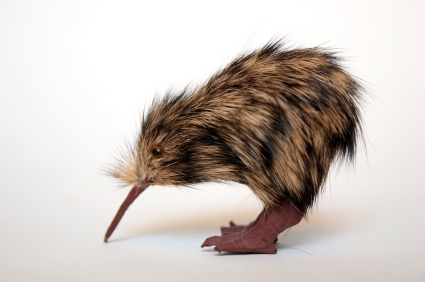 Further benefits are the monitoring and identification of stoats, rats, possums and discoveries as to how to manage the populations of these predators in the future. (For example, a recent industry in New Zealand involves the harvesting of Further benefits are the monitoring and identification of stoats, rats, possums and discoveries as to how to manage the populations of these predators in the future. (For example, a recent industry in New Zealand involves the harvesting of wild possums for their fur, which is extremely soft, warm and lightweight. With the island of New Zealand currently under siege by massive population explosions of wild possums, this is a creative solution to a troublesome issue.) In the North Island sanctuaries, the progress has been profound: Kiwi numbers have increased so dramatically that their population is expected to double by 2015. With a solid commitment to conservation efforts such as these, with any luck the New Zealanders will be able to save their national symbol for the enjoyment of generations to come. For
more information on what's currently being done to assist the Kiwi in its recovery efforts, go online to:
www.savethekiwi.org.nz. For information on the Kiwi in general, as well as where you can see the bird in captivity, go to: www.willowbank.co.nz or www.terranature.org/kiwi Photo credit: iStockphoto.com THE EURASIAN OTTER (Lutra lutra) By Erin Caslavka 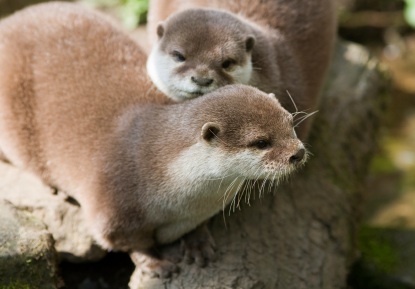 You might think of the European Otter as a sort of Don Juan of the waterways. Staking out his geographical claim (which he'll mark up to 30 times a day to indicated his presence to potential partners or competitors), the male otter will set up house with several females in different locations within his territory. You might think of the European Otter as a sort of Don Juan of the waterways. Staking out his geographical claim (which he'll mark up to 30 times a day to indicated his presence to potential partners or competitors), the male otter will set up house with several females in different locations within his territory.After they become pregnant, he'll dutifully stay with each one until she has her cubs (usually two or three at a time) which are born blind, and without fur in underground burrows called "holts." But once the cubs arrive, he'll take off in search of companionship elsewhere, and leave the care and feeding of the young solely to their mother. A wanderer by nature, the European otter hunts in swampy areas and will travel over vast tracts of land in search of food. Its favorite delicacy is eel, but it will hunt for what is easily caught. Items on the otter’s menu include fish, frogs, birds, crustaceans, insects and small mammals such as rats or rabbits. Its agility as an underwater hunter is impressive, and it can swim for up to 1,300 feet before surfacing to breath. The fur on an otter is likewise remarkable as the oil its body produces makes the hairs so water repellent that its skin never gets wet. Once seen as a pest, the otters were hunted for sport as well as for their fur. Nevertheless, they were able to maintain their population until the 1950s when pollution in European waterways wreaked havoc on the areas it called home. Given that it’s a shy and nocturnal animal, the otter was already difficult to spot but it’s become even more so due to a severe decline in its numbers. Because otters rely so heavily on fish for nourishment (they need to consume 20% of their body weight every day), their pesticide-laden meals helped to condemn them as a threatened species until conservation efforts were stepped up to save them from certain extinction. The good news? In some areas where pesticides and hunting have been banned, the European otter is making a comeback - with Ireland seeming to lead the way in terms of numbers of otters recorded. Breeding populations are once again returning to their previous haunts, and with any luck this fast and furry philanderer will once again populate the shorelines of Europe.  For more information on what's currently being done to assist the Eurasian otter in its recovery efforts, go online to: www.otterspecialistgroup.org. For information on another organization involved in recovery efforts for the sea otter (another imperiled species), contact the Monterey Bay Aquarium at: Photo credit: iStockphoto |
|
|
|
|
| Site Map |